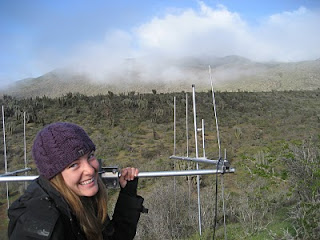I am helping study the home range of degus- where they go, who they hang out with, who they sleep with (haha) day and night. We do this by putting little radio collars on the animals and following them with telemetry- during the day we locate them once an hour, 6-8 hours a day, for 6-12 days.

The first step is to catch a bunch of animals and collar them. We use wire traps and bait them with oats. When the animals walk in they step on a treadle that shuts the door behind them, and then we walk around and check the traps every few hours. We take them out of the traps, determine the sex, reproductive status, weight, and snip a bit of the ear off to both mark that we have caught them before and for genetic analysis (at Rinconada, the field site near Santiago, the animals have ear tags with ID numbers on them).
Animals that were over 150g were big enough to be collared, which took about 4 people to successfully do! Someone holds the animal, another person holds the paws so they don't get stuck in the collar while it is being fitted, another person puts the collar on, someone pulls the ends of the wire to tighten it, another person crimps the wires once it is the proper size, and then the ends are trimmed. We put plastic tubing around the wire collars so they don't rub the animals' necks. When we are done with all this, they look like little remote control degus with their antennas sticking up!!
The radio collars emit a particular frequency, and so using 2 teams with antennas and receivers we search for the beeps until we can get a good fix on their location. Then we take a compass reading of the position and record it. We take GPS coordinates of our radio towers, and Morgan is plugging all the data into a program now which will tell us, based on the GPS position and compass readings, where the animal was at that moment in time. With 40+ points, you can get a good sense of how far an animal travels.
 Morgan with the radio tower. She was the degu finder, I was the compass reader.
Morgan with the radio tower. She was the degu finder, I was the compass reader.To figure out where they sleep at night, we use a single hand antenna attached to a receiver and walk around in the dark, pointing it at bushes until we find the strongest beep. It really is as bizarre as it sounds!! Some animals sleep in the same burrow system every night and are really easy to find, but other ones move around a whole lot and we have to tromp around the field site for a while to find them.





No comments:
Post a Comment